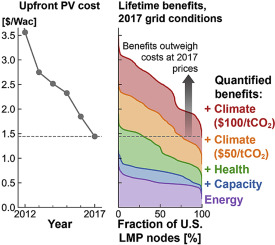Renewable and Sustainable Energy Reviews ( IF 15.9 ) Pub Date : 2019-12-26 , DOI: 10.1016/j.rser.2019.109594 Patrick R. Brown , Francis M. O'Sullivan

|
The cost of utility-scale photovoltaics (PV) has declined rapidly over the past decade. Yet increased renewable electricity generation, decreased natural gas prices, and deployment of emissions-control technology across the United States have led to concurrent changes in electricity prices and power system emissions rates, each of which influence the value of PV electricity. An ongoing assessment of the economic competitiveness of PV is therefore necessary as PV cost and value continue to evolve. Here, we use historical nodal electricity prices, capacity market prices, marginal power system emissions rates of and air pollutants, and weather data to model the energy, capacity, health, and climate value of PV electricity at over 10 000 locations across six U.S. Independent System Operators (ISOs) from 2010 to 2017. On the energy and capacity markets, transmission congestion in some locations and years results in PV revenues that are more than double the median across the relevant ISO. While the marginal public health benefits from avoided , , and PM2.5 emissions have declined over time in most ISOs, monetizing the health benefits of PV generation in 2017 would increase median PV energy revenues by 70% in MISO and NYISO and 100% in PJM. Given 2017 PV costs, electricity prices, and grid conditions, PV breaks even at 30% of modeled locations on the basis of energy, capacity, and health benefits, at 75% of modeled locations with the addition of a 50 $/ton price, and at 100% of modeled locations with a 100 $/ton price. These results suggest that PV cost decline has outpaced value decline over the past decade, such that in 2017 the net benefits of utility-scale PV outweigh the cost at the majority of modeled locations.
中文翻译:

美国电力市场中太阳能价值的时空变化
在过去的十年中,公用事业规模的光伏(PV)成本迅速下降。然而,可再生能源发电量的增加,天然气价格的下降以及整个美国排放控制技术的部署,导致电价和电力系统排放率同时发生变化,而每一种变化都会影响光伏发电的价值。因此,随着PV成本和价值的不断发展,有必要对PV的经济竞争力进行持续评估。在这里,我们使用历史节点电价,容量市场价格,边际电力系统排放率和空气污染物,以及天气数据,以模拟2010年至2017年美国6个独立系统运营商(ISO)超过1万个地点的光伏发电的能量,容量,健康和气候价值。在能源和容量市场上,传输拥堵在某些地区和年份,PV收入是相关ISO的中位数的两倍以上。边际公共卫生得益于避免, ,而且大多数ISO的PM 2.5排放量都随着时间的推移而下降,如果将2017年光伏发电的健康收益货币化,MISO和NYISO的PV能源收入中位数将增加70%,PJM的100%。考虑到2017年的光伏成本,电价和电网状况,基于能源,容量和健康收益,在30%的建模地点,PV收支平衡,在75%的建模地点,每吨增加50美元 价格,并且在100%的建模位置以100美元/吨的价格 价格。这些结果表明,在过去十年中,光伏成本下降的速度超过了价值下降的速度,因此在2017年,公用事业规模光伏的净收益超过了大多数建模地点的成本。

























 京公网安备 11010802027423号
京公网安备 11010802027423号